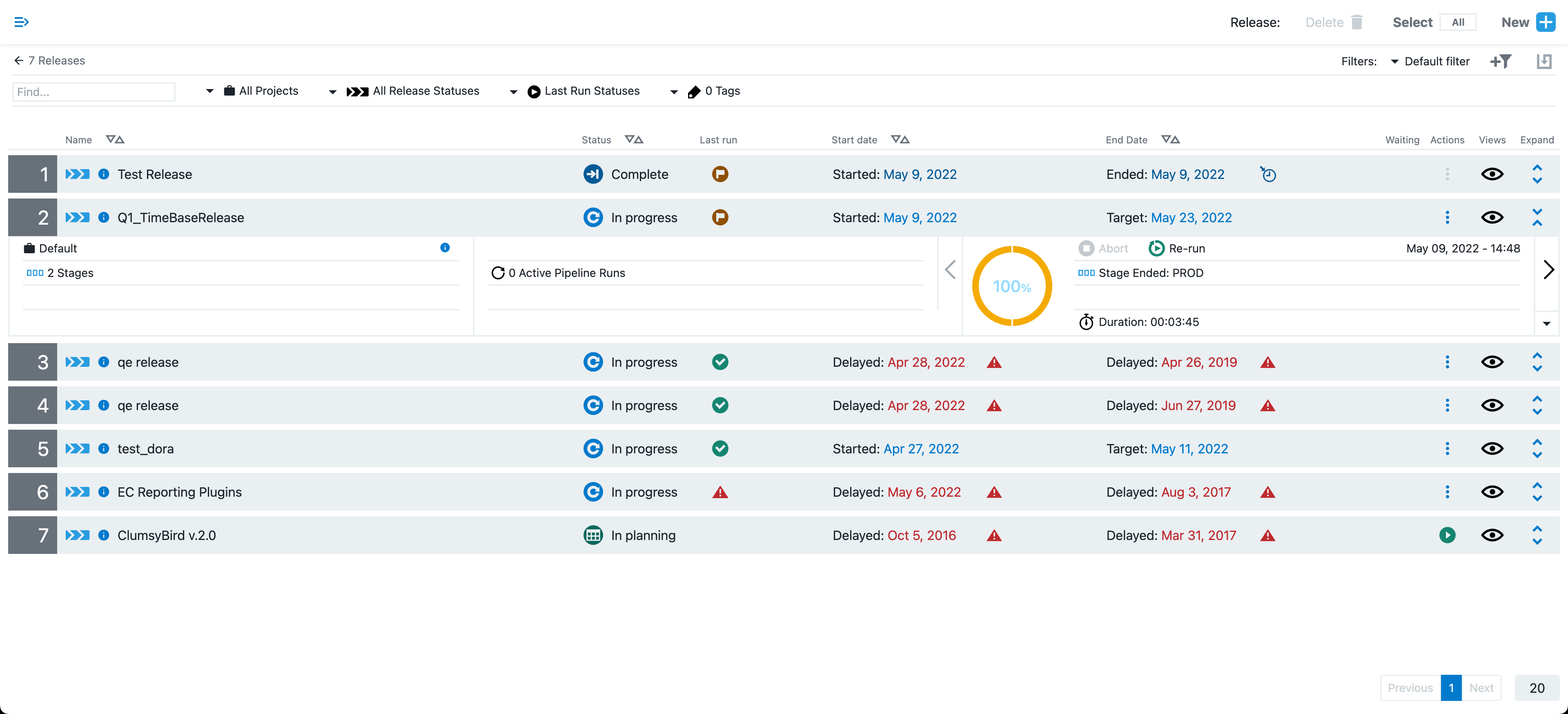The Release Dashboard, also referred to as the Release List, provides a way for the release team, task assignees, and approvers to view the status of all planned, active, and completed releases. You can view the current status, specific tasks and assignments, and start and end dates for stages in one place, on one platform.
Release dashboard
The Release Dashboard shows all the releases that you have permission to view:

By default, CloudBees CD/RO displays releases for all projects.
To view only the objects for a specific project, select the down arrow in the All projects field and select one or more projects in one of the following ways:
-
Select the name of one or more projects.
-
Enter the search criteria in the Search field. The projects that match the criteria display in the list.
If there are no matches, a message displays stating that there are no resource templates in the selected projects.
The Release Dashboard displays the following information:
Each row in the Release Dashboard contains this information: |
|
Name |
The name of the release. Select the name to access the Release editor view for the release. |
Status |
The status can be:
|
Last Run |
The status of the last run. Select the icon to expand the row. |
Start date and time End date and time |
The default time frame between the start and target (end) dates is two weeks. The color of the dates indicates the release status.
|
Waiting |
A hand icon in this column indicates the release is pending on manual input. Select the icon for further information. |
Actions |
Either the Run Release button or the Actions button displays in this column. Select Start release to start the release. Otherwise, click Actions to select one of these actions:
|
Views |
Select Views for other available views for this release. Choices are context-sensitive based on status of the release. |
Expand |
Select Expand to view more details about the release. |
Release details in the expanded view |
|
Project to which the pipeline belongs, name of the pipeline underlying the software release, and the number of stages in this pipeline |
Example: 
|
Number of applications in the pipeline and any notifications for actions to be taken before the pipeline progresses |
Example: 
This pipeline requires human intervention to progress.The user named quincy needs to approve something at an entry or exit gate of a stage before the pipeline progresses. |
Visual indicator showing how far the Release has progressed with the percentage completed, the current stage, and how long the Release has been running. |
The visual indicator is split into sections equal to the number of stages in the pipeline. If pipeline has three stages, it is split into three segments. |
Creating a new release
To configure a new release:
-
Select New
 .
. -
Select Create new.
-
Enter a title for the release in Name.
-
Select the project from the Select project options.
-
Select the Start date and End date and times.
CloudBees added start and end times with v.2023.02.0. This information is not backward compatible in DSL. You cannot import generated DSL of release objects from v2023.02.0 to earlier versions without manual changes. -
Select
 add arrow to add tags. For more information, refer to
Object Tags.
add arrow to add tags. For more information, refer to
Object Tags. -
Select Next.
-
Choose a pipeline.
-
Select Create new pipeline to create a custom pipeline or select an existing pipeline to copy.
-
-
Select Next.
-
Use the Release editor features to configure the release pipeline. For more information, refer to Pipeline UI.
Copying an existing release
To duplicate an existing release:
-
Select New
 .
. -
Select Copy Existing.
-
Select the
Nameof the release to be copied. -
Enter a title for the release in Name.
-
Select the project from the Select project options.
-
Select the Start date and End date and times.
-
Select
 add arrow to add tags. For more information, refer to
Object Tags.
add arrow to add tags. For more information, refer to
Object Tags. -
Select Disable Pipeline Restart stop pipeline from automatically restarting.
-
Select Disable Multiple Active Runs to prevent the pipeline from having more than one active run.
-
Select Stage skipping to allow users or groups to skip pipeline stages.
-
Select Override Workspace use instead specific workspace in place of a procedure or process workspace.
-
-
Select Next.
-
Use the Release editor features to configure the release pipeline. For more information, refer to Pipeline UI.
Creating a new release from a template
To create a release template using the Self-Service catalog, edit the dsl code for the existing catalog item and change templateObjectType = none to templateObjectType = release. For more information, refer to Service catalog.
|
To create a release based on a release template:
-
Select New
 .
. -
Select Create from catalog item.
-
Select the release template
name. -
Select a project name from the Release project menu.
-
Enter a title for the release in Name.
-
Enter a description in Description.
-
Select the Start date and End date and times.
-
Select OK.
-
Use the Release editor features to configure the release pipeline. For more information, refer to Pipeline UI.